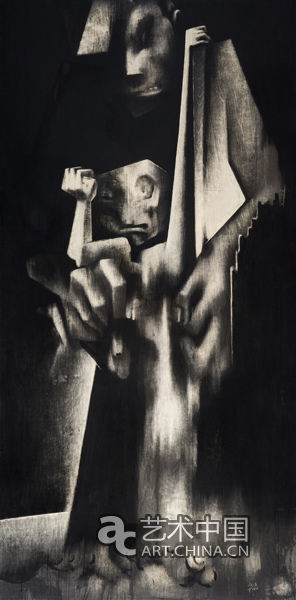
许向东 2010年母与子(二) 2010 Mother & Son No.2 122cm×244cm 木板综合媒质 synthesized material on wood 2010.tif
Exhibition Listing on Dec of NEW AGE GALLERY
Theme: palpitate--Xu Xiangdong’s Solo Exhibition
Opening: Dec 18th, 2010, 4:00pm
Date: Dec 18th 2010—Jan 16th 2011
Venue: Beijing New Age Gallery
8502#, D09 Area, 798 Zhong Er St., No.4 Jiu Xian Qiao Road, Chao Yang District, Beijing. PC: 100015
Tel: +86-10-59789282
Fax: +86-10-59789285
E-mail: newage4355@yahoo.com.cn
Web: www.newageartgallery.com
As a teacher at Printmaking Department, Central Academy of Fine Arts, Xu Xiangdong has been entirely devoted to study, exploration and innovation in art language in the past decades. He aims to build a new system of plastic language in art out of his in-depth research and deep understanding of the East and the West, particularly their respective plastic language and culture plus his single-minded pursuit of art language itself. His works, viewed as a whole, seem to be aloof from the so-called contemporary art, but it is such distance that keeps him alert and independent, thus allowing his art production a unique style, making him all the more “contemporary”.
As early as the end of 2007, Xu Xiangdong held at Beijing New Age Gallery and Art Museum of Central Academy of Fine Arts his exhibitions under the title of Qi Form, which, for the first time, offered the public a full view of his painstaking effort in art creation and study, his unique understanding and treatment of art in particular. Board, used as a direct and independent means of art expression, got its expressive particularity fully displayed. It had actually become a medium of art expression and display. With him, board Painting regained its due pure aesthetic significance. With saw blade, he made full use of the beautiful wood texture by creating images following the natural patterns,highlighting “emptiness” and “negative form” in plastic language. (“Positive form” and “real image” refer to the objective existence for painting and what goes beyond them are “negative form” and “virtual image. He believes that what our eyes “contemplate” in the universe is in nature and cosmos, relating to its surroundings, including air and the cosmos, in an organic way in the form of Qi. The “form” of a matter is not a purely objective and isolated one. Moreover, “Qi”, in Chinese traditional culture, and to Chinese people as well, is the basis of everything and its own eternal cycle. As the fundamental substance to maintain life, nature, society and the divine order, it is based on the Chinese’s experience of life and their interpretation of the law of life in the universe through the movement of “Qi”. As a result, while presenting everything in the universe, we concern ourselves with more than its visible superficial form and boundary, and we have to instead focus more on the co-existence and symbiosis between image and Qi, image and the atmosphere, and giving emphasis to the invisible “negative form” or “form of Qi”, and every substance along with its Qi from its cycle. In this way we show our deep understanding of nature, the cosmos and life as well.) The paintings generate rich “forms” and “images” in the black chaos. The “board” does not only allow but also require vast “emptiness”, so the artist creates a strong sense of imminence, overall momentum and visual tension by starting with “big forms and big structure” and applying “the principle of close look”. The originality comes form his persistent curiosity about printmaking and plastic art in his teaching career.
The coming solo exhibition will be a presentation of his progress in the past three years as an artist. As is suggested in the title “palpitate” which means shock, fear and even terror, the exhibition is intended to show the shocking conflict in art when Eastern art comes into contact with the Western counterpart amid globalization. The pictorial language and its “forms” and “images” will also bring startling effect. Moreover, the work is a strong emotional embodiment of the amazement and shock that nature and life bring to humanity (artists).
The works to be presented are proofs of his pioneering spirit in art and his pursuit and innovation. By study Chinese traditional painting and Western easel painting, their similarities and differences, he found out the reason why easel painting has always offered great room for study. Based on his experience in his previous study of plastic language, he made several discoveries. Initially, a “real image” and a “virtual image” co-exist in a work. Secondly, the “virtual image” seems to be more important of than the other, for it is the concept, mental image and principal motif the artist aims to convey. Thirdly, the “virtual image” adds more to the layout and significance of a work. Lastly, in the confine of the quadrangle of the easel, the “virtual image” is capable of strong sense of composition and rhythm, potentially conforming with the habit and satisfying the standard in visual aesthetics. His work thus takes on an effect that is both abstract and concrete, with the images becoming more intense and more “sculpture-like”, striking the audience with strong composition and rhythm.
As an artist, Xu Xiangdong is by all means unique no matter in terms of his exploration and innovation in plastic language, his choice of board as medium for his plastic language to make use of its property as material, or his exploitation of the function of white and black in traditional painting. We have every reason to believe that his solo exhibition will bring the audience new visual enjoyment and inspiration in the form of “palpitating” and shock.